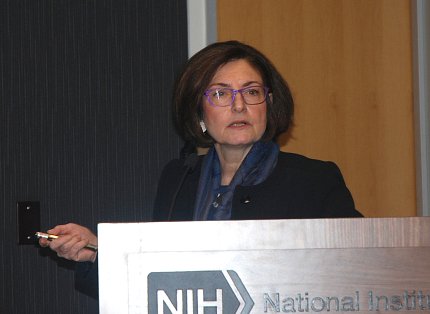Exercise Can Counteract
Columbia’s Fried Describes Syndrome of Frailty

Photo: Rich McManus
You get the feeling that if Dr. Linda P. Fried, dean of the Mailman School of Public Health at Columbia University, were in charge of things, exercise classes for frail adults would be as common across the land as kindergarten enrollment is for youngsters.
There’s a canard among those who study older adults: A gerontologist can spot frailty at 50 yards. Fried examined it much more closely—“from cells to society”—and reported her findings Jan. 14 for an NIH audience in the Porter Bldg.
“This is something I’ve been trying to figure out for several decades,” said Fried, who explained that, for the past 60 years, the descent from resilience to frailty in some older people has been the “raison d’etre” of geriatric medicine in the United States. “Who are these people and why is this going on?”
Everyone who ages experiences some degree of loss of resilience, but not every senior citizen becomes frail, a state highly predictive of death within 3 years. Fried is interested in preventing the advance of frailty syndrome in those most vulnerable to its ravages.
“We know that frailty increases with age,” she said. “It appears to be a distinct physiological state” characterized by a constellation of markers. “We all think we know it when we see it. However, the science of characterizing the phenotype of frailty and its underlying biology takes us beyond our assumptions.”
Markers include loss of: muscle mass (sarcopenia); strength and power; energy motor speed; and activity. In advanced stages, it includes chronic undernutrition, which accelerates the cycle of decline.
A phenotype for a new clinical syndrome has emerged with 5 characteristics; a person with 3 to 5 of them is clinically frail, while 1 to 2 is considered pre-frail. These include shrinking (unintentional weight loss), weakness, poor endurance, slowness and low activity.

Photo: Rich McManus
Fried filled in the frailty picture with results from three major population-based studies of older adults; one focused mainly on cardiovascular health and the other two were women’s health and aging studies.
She found that frail adults were at “high risk of a lot of bad outcomes,” including death, falls, hospitalization, burns and surgery. In short, frailty appears to predict high risk.
Further, it is a chronic, progressive process, whereby a frailty score of 1 or 2 is likely to advance to a 3 within 3 years. A score of 5 is highly predictive of death within 6 months.
“We have found that frailty is a vicious cycle of dysregulated energetics,” said Fried. In 2013, physical frailty was declared a clinical syndrome. Fried thinks everyone over age 70 should be screened for it.
Peering below the waterline of overt symptoms, Fried and her colleagues have found “a large number of physiological systems being disrupted” in frailty. These include anemia, inflammation, immune deficits, nutrient deficiency, abnormal blood tests, altered insulin-glucose dynamics and dysregulation of hormones, among other problems.
“Something is going on beyond any one symptom,” she said. “There is a large amount of dysregulation across many systems for people who are frail. And the odds go up more than linearly as the number of frailty markers rises—there is an acceleration as more systems are involved, so that the whole is greater than the sum of the parts…What is driving this aggregate loss of reserves?”
Fried and her colleagues have found that, even at the molecular and genetic level, frailty is characterized by an inability to adapt to stressors. “Dysregulation of energy metabolism may be the root of frailty,” she said. “These patients have far fewer reserves and less resilience.”
Frailty tends to be a background vulnerability rather than the presenting disease for which one is typically hospitalized, Fried explained. But sadly, “Putting a frail person in the hospital is perhaps the ultimate stress test.”
The good news is that frail adults respond to exercise, sometimes in dramatic fashion. “Physical activity up-regulates all kinds of functions,” Fried said. “It’s a very nice model of what we would be driving for…If we understand the syndrome accurately, there are lot of ways to intervene.”
So, have you signed grandma and grandpa up for “kindergarten” yet?
